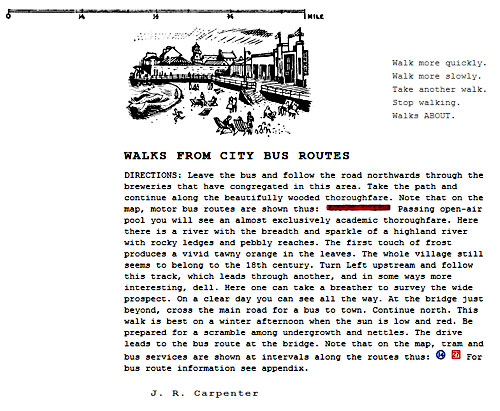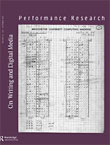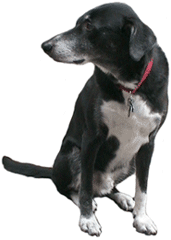Walks from City Bus Routes is a web-based computer-generated guide ‘book’ which perpetually proposes plausible yet practically impossible walking routes through the city of Edinburgh and its environs using JavaScript developed by Caden Lovelace and images and text culled from a City of Edinburgh Transport Map published by the Edinburgh Geographical Institute in the 1940s and a pamphlet called Walks from City Bus Routes published by Edinburgh City Transport in the late 1950s.

Walks from City Bus Routes has been published in the Spring 2015 issue of The New River – a long-standing online journal of digital writing & art founded by Edward Falco with help from Len Hatfield in 1996. The New River posts new issues twice a year in December and May, and is currently hosted by Virginia Tech’s Center for Digital Discourse and Culture. This Spring 2015 issue is edited by Arian Katsimbras & Emily Dhatt and contains work by Alan Bigelow, J. R. Carpenter, Chris Joseph, J.P. Sipilä, Aaron Oldenburg, Jody Zellen.
Readers keen on web-based bookish-drifting-wander-walking may also be interested in Wanderkammer: A Walk Through texts, a web-based collection of hyperlinked quotations from great writing on walking. Wanderkammer first appeared Walk poems: A series of reviews of walking projects edited by Louis Bury Corey Frost published on Jacket2 in 2011.
 The latest issue of Performance Research Journal,
The latest issue of Performance Research Journal, 
 The week we thought Isaac the Wonder Dog was dying (see August posts) I had a massive anxiety attack about In-situ Cité. In the long hours spent sitting and waiting on the concrete floors of vets and animal clinics my whole idea of neighbourhood and community and humanity underwent some major revisions.
The week we thought Isaac the Wonder Dog was dying (see August posts) I had a massive anxiety attack about In-situ Cité. In the long hours spent sitting and waiting on the concrete floors of vets and animal clinics my whole idea of neighbourhood and community and humanity underwent some major revisions.